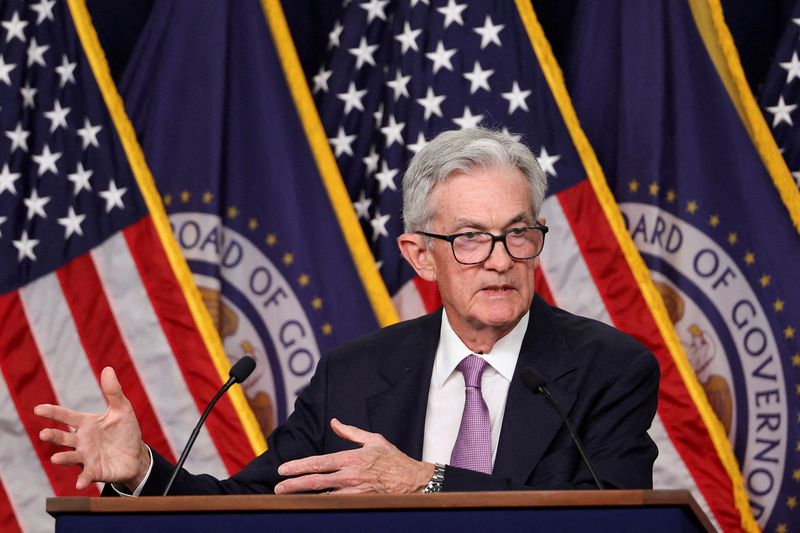
A look at the day ahead in U.S. and global markets from Mike Dolan
After a typical skittish first-day reaction, world markets are on Thursday embracing the new Federal Reserve stance as insurance on the holy grail of a soft economic landing.
Fed boss Jerome Powell described Wednesday’s outsize half-point interest rate cut as a ‘recalibration’ rather than some panicky emergency, and investors are taking the move as a sign the Fed will seek that new ‘neutral’ quickly without necessarily being forced into it by a weakening economy.
There was only one dissenter – Fed governor Michelle Bowman – who clearly felt the economy only needed a quarter point cut.
All in, that’s precisely the balance prayed for by stock markets all year. And even though Wall Street recoiled by the close, futures are surging 1-2% again to new records ahead of today’s bell.
Treasuries seem comfortable that they had it all priced in advance, with two-year yields hovering near two-year lows just under 3.6% on Thursday and the 2-to-10 year yield curve gap edging up to 10 basis points – its most positive since mid-2022.
The dollar briefly set a new low for the year after the Fed cut, but has since steadied, with dollar/yen jumping ahead of the Bank of Japan’s latest decision on Friday. Sterling hit its best level in 30 months as the Bank of England is expected to pass on another rate cut later today.
Shifting the emphasis from inflation to the jobs market, Powell and colleagues – via his press conference and the Fed’s updated economic and rate projections – signalled another 50 basis points of easing by yearend and a further 100bps in 2025.
Cutting inflation forecasts to within a tenth of a percentage point of the Fed’s 2% target next year and nudging their unemployment rate call up to 4.4%, they set fair on a return to what officials now see as the long-term neutral rate.
And even though they took that ‘long-term’ rate up a tenth to 2.9%, they expect to get there by 2026 – about 200bps lower than the new policy rate of 4.75-5.00%.
Even though the Fed indicated another 50bps of cuts over the two remaining meetings of this year, futures have moved ahead to price more than 70bps – and almost 200bps of cuts by this time next year.
Bank of America, for one, now sees 75bps of cuts by yearend – arguing that emphasis on keeping ahead of any labor market weakness may see the Fed “pushed into deeper cuts.”
With jobs data super sensitive from here on, the weekly jobless claims numbers on Thursday will be a first test.
On the flip side, Wednesday’s big cut underscores what appears to be a rebounding housing market and that should support the ongoing expansion – running at an estimated 3% in the current quarter. As 30-year fixed mortgage rates have now fallen to two-year lows of 6.15%, housing starts surged more than 15% last month.
As for financial markets, the basic rule of thumb is that when the Fed has previously started cutting rates into an ongoing economic expansion then stocks gain more than 16% on average over the following year – led by both large cap and small cap growth stocks.
Futures on the small cap Russell 2000 index were up almost 3% ahead of Thursday’s open.
With U.S. futures on a tear on Thursday, world stocks rallied broadly in the slipstream. Tokyo and Hong Kong benchmarks climbed 2%, with the former flattered by the yen’s pullback and the latter by the lock-step rate cut from HK’s monetary authority.
Chinese stocks also rose on hopes the Fed move will give Beijing policymakers room to ease as soon as Friday – helped by a strengthening of the offshore yuan to its best levels since May last year.
European stocks were 1% higher too.
Elsewhere, the Fed’s easing bug was less infectious.
Even though the BoE on Thursday is expected to defer a second UK rate cut of the year to November, it will update on its ongoing process of balance sheet reduction.
If it repeats prior years’ targets of a 100 billion pounds runoff over the next year, that could reduce active BoE bond sales sharply because a heavy schedule of maturing debt over that horizon will see bonds fall off organically over the coming 12 months.
Norway also held the line and its central bank left rates unchanged at 4.5% on Thursday. And Brazil went in the opposite direction and raised its rates for the first time in two years on Wednesday.
Key developments that should provide more direction to U.S. markets later on Thursday:
* Bank of England policy decision, meeting minutes and annual balance sheet target; Reserve Bank of South Africa and Central Bank of Turkey make policy decisions
* US weekly jobless claims, September Philadelphia Fed business survey, August existing home sales, Q2 current account
* European Central Bank board member Isabel Schnabel speaks

* US Treasury sells 10-year inflation-protected securities
* US corp earnings: FedEx (NYSE:FDX), Lennar (NYSE:LEN), Darden Restaurants (NYSE:DRI), Factset
(By Mike Dolan, editing by Christina Fincher; mike.dolan@thomsonreuters.com)
This post is originally published on INVESTING.




